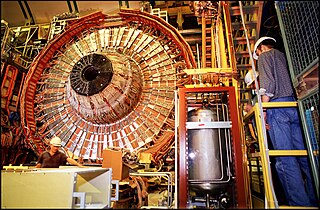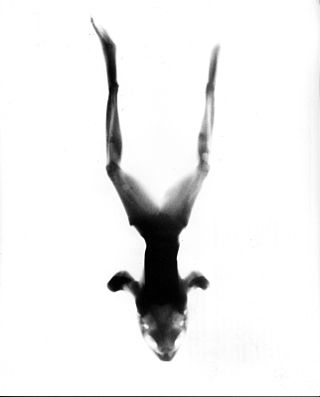
Geant4 is a platform for "the simulation of the passage of particles through matter" using Monte Carlo methods. It is the successor of the GEANT series of software toolkits developed by The Geant4 Collaboration, and the first to use object oriented programming. Its development, maintenance and user support are taken care by the international Geant4 Collaboration. Application areas include high energy physics and nuclear experiments, accelerator and space physics studies. The software is used by a number of research projects around the world.

DELPHI was one of the four main detectors of the Large Electron–Positron Collider (LEP) at CERN, one of the largest particle accelerators ever made. Like the other three detectors, it recorded and analyzed the result of the collision between LEP's colliding particle beams. The specific focus of DELPHI was on particle identification, three-dimensional information, high granularity (detail), and precise vertex determination.

The ISOLDE Radioactive Ion Beam Facility, is an on-line isotope separator facility located at the centre of the CERN accelerator complex on the Franco-Swiss border. Created in 1964, the ISOLDE facility started delivering radioactive ion beams (RIBs) to users in 1967. Originally located at the Synchro-Cyclotron (SC) accelerator, the facility has been upgraded several times most notably in 1992 when the whole facility was moved to be connected to CERN's ProtonSynchroton Booster (PSB). ISOLDE is currently the longest-running facility in operation at CERN, with continuous developments of the facility and its experiments keeping ISOLDE at the forefront of science with RIBs. ISOLDE benefits a wide range of physics communities with applications covering nuclear, atomic, molecular and solid-state physics, but also biophysics and astrophysics, as well as high-precision experiments looking for physics beyond the Standard Model. The facility is operated by the ISOLDE Collaboration, comprising CERN and sixteen (mostly) European countries. As of 2019, close to 1,000 experimentalists around the world are coming to ISOLDE to perform typically 50 different experiments per year.

Thomas Jefferson National Accelerator Facility (TJNAF), commonly called Jefferson Lab or JLab, is a US Department of Energy National Laboratory located in Newport News, Virginia.
The HERA-B detector was a particle physics experiment at the HERA accelerator at the German national laboratory DESY that collected data from 1993 to 2003. It measured 8 m × 20 m × 9 m and weighed 1000 tons. The HERA-B collaboration consisted of some 250 scientists from 32 institutes in 13 countries.

The Lazarus effect refers to semiconductor detectors; when these are used in harsh radiation environments, defects begin to appear in the semiconductor crystal lattice as atoms become displaced because of the interaction with the high-energy traversing particles. These defects, in the form of both lattice vacancies and atoms at interstitial sites, have the effect of temporarily trapping the electrons and holes which are created when ionizing particles pass through the detector. Since it is these electrons and holes drifting in an electric field which produce a signal that announces the passage of a particle, when large amounts of defects are produced, the detector signal can be strongly reduced leading to an unusable (dead) detector.
T2K is a particle physics experiment studying the oscillations of the accelerator neutrinos. The experiment is conducted in Japan by the international cooperation of about 500 physicists and engineers with over 60 research institutions from several countries from Europe, Asia and North America and it is a recognized CERN experiment (RE13). T2K collected data within its first phase of operation from 2010 till 2021. The second phase of data taking is expected to start in 2023 and last until commencement of the successor of T2K – the Hyper-Kamiokande experiment in 2027.

Neutron spectroscopy is a spectroscopic method of measuring atomic and magnetic motions by measuring the kinetic energy of emitted neutrons. The measured neutrons may be emitted directly, or they may scatter off cold matter before reaching the detector. Inelastic neutron scattering observes the change in the energy and wavevector of the neutron as it scatters from a sample. This can be used to probe a wide variety of different physical phenomena such as the motions of atoms, the rotational modes of molecules, sound modes and molecular vibrations, recoil in quantum fluids, magnetic and quantum excitations or even electronic transitions.
The helical orbit spectrometer (HELIOS) is a measurement device for studying nuclear reactions in inverse kinematics. It is installed at the ATLAS facility at Argonne National Laboratory.

Neutron imaging is the process of making an image with neutrons. The resulting image is based on the neutron attenuation properties of the imaged object. The resulting images have much in common with industrial X-ray images, but since the image is based on neutron attenuating properties instead of X-ray attenuation properties, some things easily visible with neutron imaging may be very challenging or impossible to see with X-ray imaging techniques.
Conversion electron Mössbauer spectroscopy (CEMS) is a Mössbauer spectroscopy technique based on conversion electron.

Kim Sun-kee is a South Korean physicist. He is professor in Seoul National University and director of the Korea Invisible Mass Search. He was the first director of the Rare Isotope Science Project within the Institute for Basic Science and is a member of the Korean Academy of Science and Technology.
The Laboratori Nazionali di Legnaro is one of the four major research centers of the Italian National Institute for Nuclear Physics (INFN). The primary focus of research at this laboratory is in the fields of nuclear physics and nuclear astrophysics, where five accelerators are currently used. It is one of the most important facilities in Italy for research in these fields. The main future project of the laboratory is the Selective Production of Exotic Species (SPES), in which various radionuclides will be produced for research and medicinal purposes.

Volker D. Burkert is a German physicist, academic and researcher. He is a Principal Staff Scientist at the Thomas Jefferson National Accelerator Facility at Jefferson Lab (JLab) in Newport News, Virginia (USA). He has made major contributions to the design of the CEBAF Large Acceptance Spectrometer (CLAS) that made it suitable for high luminosity operation in experiments studying spin-polarized electron scattering.
Eric B. Norman is an American physicist. He is a professor in the graduate school of the University of California, Berkeley.
Steven Michael Errede is an American experimental physicist, known for his leadership in the collaboration that experimentally confirmed the existence of the top quark.
Linda Gail Stutte is an experimental elementary particle physicist. After an appointment as a postdoc at Caltech in 1974–76, Stutte was a research staff scientist at the Fermi National Accelerator Laboratory from 1976 through her retirement in 2007. She is known for work on neutrino experiments and her expertise with Fermliab neutrino beam facilities.

The ISOLDE Solenoidal Spectrometer (ISS) experiment is a permanent experimental setup located in the ISOLDE facility at CERN. By using an ex-MRI magnet, heavy radioactive ion beams (RIBs) produced by the HIE-ISOLDE post-accelerator are directed at a light target and the kinematics of the reaction is measured. The purpose of the experiment is to measure properties of atomic nuclei replicating the conditions present in some astrophysical processes, such as the production of chemical elements in stars. The experiment will also produce results that provide a better understanding of nucleon-nucleon interactions in highly-unstable, very radioactive (exotic) nuclei.

The Multi Ion Reflection Apparatus for Colinear Laser Spectroscopy (MIRACLS) is a permanent experiment setup being constructed at the ISOLDE facility at CERN. The purpose of the experiment is to measure properties of exotic radioisotopes, from precise measurements of their hyperfine structure. MIRACLS will use laser spectroscopy for measurements, aiming to increase the sensitivity of the technique by trapping ion bunches in an ion trap.
Associated particle imaging (API), sometimes referred to as the tagged neutron method (TNM), is a three dimensional imaging technique that maps the distribution of elements within an object. In associated particle imaging, deuterium-tritium fusion reactions each produce a fast neutron and an associated particle, which travel in opposite directions in the center-of-mass frame. By measuring the timing and position of the associated particle, the trajectory of the neutron may be inferred. The neutron may then enter an object of interest where it is likely to undergo inelastic scattering. This produces one or more gamma-rays of specific energies dependent on the element that the neutron scatters off of. By measuring the gamma-ray energy, the element may be identified. The timing of the gamma-ray coinciding with an associated particle allows the 3D imaging of an object's elemental composition. This technique has applications in agriculture, national security, and diamond detection, among other areas.










